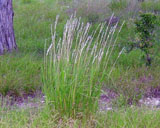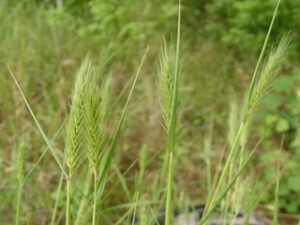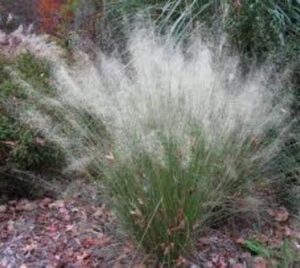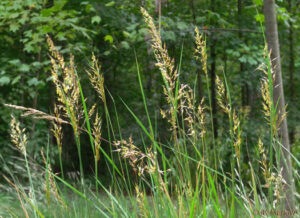Focus on a Native: Hill Country Grasses
by CMG Betty J
The Texas Hill Country is a defined area of nineteen counties situated within the Edwards Plateau. Since the region takes up about 24 million acres, the diversity of its flora and fauna reflects that vast size. Some 280 species of grasses are found here. Some are native and some have been introduced, either intentionally or not. Texas Parks and Wildlife lists the five most common grasses for the Edwards Plateau as silver bluestem, Canada wildrye, big muhly, little bluestem and Indian grass.
Native grasses provide food for wildlife and some grazing for cattle. The deep grass roots protect slopes from erosion and keep the soil from compacting so water can seep into the aquifer below.

Silver Bluestem
Silver bluestem, Bothriochloa laguroides, is a warm season perennial bunch grass that displays silver, fluffy-flowered inflorescence. From May through November, its easily recognizable blooms sway in the wind and catch the sunlight for a stunning display. If used in the landscape, take care to contain it as it spreads quickly.

Canada Wildrye
Canada wildrye, Elymus Canadensis, is a tall, native bunchgrass. A cool season perennial grass, it has seedhead spikes that resemble wheat or barley. The seedheads droop downward giving it another common name, nodding wildrye. The young plants are a nutritious forage and the thick bunches provide good cover for small mammals and birds. It is the larval host to the zabulon skipper butterfly and blooms in March with seedheads forming from May through December.

Big Muhly
Big muhly, also called Lindheimer muhly, Muhlenbergia lindheimeri, is another native, warm season perennial bunchgrass that thrives on the Edwards Plateau. Its feathery florescence grows from 8-16 inches atop stalks that may be as tall as six feet. As a landscape component it can be used effectively as either a screen or an individual accent, sometimes in place of pampas grass. Locate it in an area with full sun or light shade and expect blooms from September until December.

Little Bluestem
Little bluestem, Schizachyrium scoparium, is a warm season perennial bunchgrass. Its dense root system may extend down as far as eight feet, making it an excellent soil stabilizer. Its blue-green stems turn a rich russet color in the fall. The seeds are small and fuzzy, growing alternately along the awns of the 24-36 inch stems. Little bluestem is the host plant to the common wood nymph, Leonard’s skipper and swarthy skipper butterfly larvae. It blooms from August through December with seedheads forming in September.

Indian Grass
Indian grass, also known as yellow Indian grass, sorghastrum nutans, is a tall perennial native bunchgrass with long, wide leaf blades. The 30-36 inch seed stalks are topped with golden spikes. This grass occurs both in bunches and as a single stem among other grasses. It is a prolific seed producer and provides a good source of seeds for small mammals and birds. In nature it is very drought and cold tolerant, but in the landscape, it prospers best in a moist area. The bloom begins in mid-spring and seeds are produced from September until December.